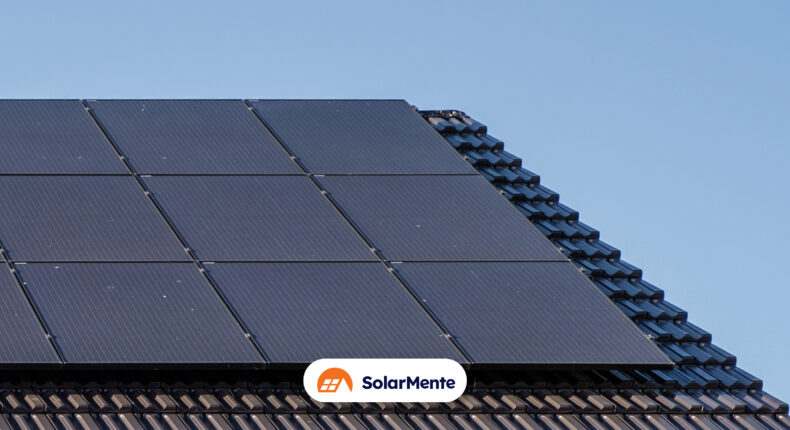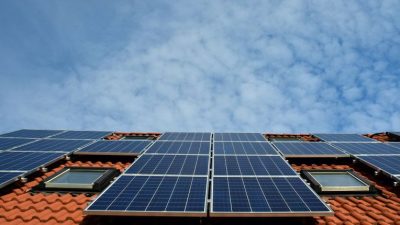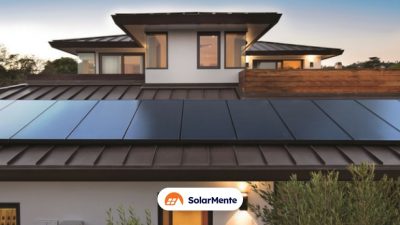Choosing one type of panel or another for the home has an impact on photovoltaic production.
But how do we differentiate between the different models and why do we find different shades?
Well, polycrystalline solar panels are characterised by a bluish colour and are often used in industrial installations at a lower price than monocrystalline panels.
In today’s article, we will therefore look at the characteristics of polycrystalline panels and how they differ from monocrystalline panels.
Characteristics of polycrystalline solar panels
These panels are made of silicon, in the same way as a monocrystalline panel, but they use a different technology that influences the performance as well as the design.
Although both are made of silicon, the manufacturing process is different.
Monocrystalline panels are formed from sheets of silicon that are cut to increase purity and achieve higher performance. Polycrystalline silicon, on the other hand, is melted and added to moulds that form the individual solar panels. It is not a methodology that requires such a precise and demanding technique, so they are created more quickly and at a lower cost.
However, the impurities generated reduce their performance compared to monocrystalline ones. The molten silicon portions leave little space, making it difficult for electrons to move.
In addition, a polycrystalline panel is characterised by a bluish colour.
Monocrystalline or polycrystalline solar panels? We analyse the differences between the two technologies
The main difference between the two panels lies in the way they are manufactured, the process of which will have an impact on the following factors:
Efficiency
The efficiency of polycrystalline panels is between 14% and 16%, i.e. the capacity of the system to generate electricity from the sun’s rays received. This is lower than the efficiency of monocrystalline panels, as they use less advanced technology.
Although some manufacturers in China are achieving more efficient shares (19%) with the use of polycrystalline cells, they do not have the same performance as a monocrystalline panel whose maximum efficiency can reach 25.6%.
With more than 75% of the market, monocrystalline solar panels are the dominant technology.
Price
In addition to the difference in performance between the two panels, there is also an appreciable variation in cost due to the silicon structure from which they are made.
On the one hand, polycrystallines melt the silicon and pour it into square moulds. The wafers are then cut into individual modules.
On the other hand, monocrystalline technology has a more complex manufacturing process where the wafers are cut in order not to reduce their efficiency. For this reason, the care that is applied is higher and more labour-intensive. This will result in an increase in the price of solar panels.
Temperature coefficient
This is a factor that indicates the loss of power generated for each degree that increases depending on the average temperature of the panels, which is 25ºC.
The loss generated can be as low as -0.40%. A very low percentage. In fact, the lower this figure is, the higher the performance of the panel and the loss of efficiency produced will be barely perceptible.
This indicator is determined by the type of panel used. In this sense, monocrystalline panels have more advanced technological features and therefore offer a higher yield than polycrystalline panels.
Size
The dimensions of one panel or another vary. It is common to find polycrystalline technology panels with 72-cell modules measuring 2m x 1m and arranged in 12 rows of 6.
Monocrystalline panels, on the other hand, consist of 60 cells in 10 rows of 6 cells.
The advantage of monocrystalline is that with a smaller or similar size, they are able to produce more electrical energy for photovoltaic self-consumption. This is a key point to note considering that most homes have limited space.
Colour
It may not be the most important difference, but it is a way to identify them easily.
Starting with polycrystalline modules, the bluish hue is achieved by melting the raw silicon. It is then transferred directly into a mould. From this point on, we can appreciate the diversity of crystals that form the cells with simplicity.
Monocrystalline panels, however, are composed of a single cell and a single silicon crystal, which is why the colour is more homogeneous and darker.
In short,the main differences between polycrystalline and monocrystalline panels are as follows:
-
The manufacturing process
-
The yield obtained from each technology
-
The price of the solar panels
-
The temperature coefficient
-
The size of each type of panel
-
The colour of each one
When are polycrystalline solar panels used?
A polycrystalline solar panel is recommended for the following cases:
-
In large geographical areas.
-
For areas that receive a significant amount of sunlight throughout the day.
-
When cost is most important.
-
In situations where aesthetics is not a priority.
For these same reasons, their main use is associated with the industrial sector, where there are no problems of space for installations and they receive constant sunlight. It is due to the availability of privileged locations of great amplitude that are not harmed by shadows.
Advantages and disadvantages of polycrystalline solar panels
Finally, we will make a brief summary of the advantages and disadvantages of polycrystalline panels:
Advantages
Among the best qualities of this technology are:
-
They are cheaper than monocrystalline panels.
-
They have a long useful life.
Disadvantages
However, there are the following disadvantages:
-
Inferior efficiency in energy production.
-
They require large spaces for installation.
-
Less heat tolerant.
In conclusion, is a monocrystalline or polycrystalline panel better?
The answer varies depending on the use of these panels.
For the industrial sector, polycrystalline modules are a more cost-effective option. The cost is lower and there is no space problem in the installation of the system.
However, they do not require the performance necessary for residential self-consumption. In this case, monocrystalline panels remain the best choice as they produce more electricity in a small or similar space.
>> If you want to find out how much you can save per month on your electricity bill, try our self-consumption calculator.














